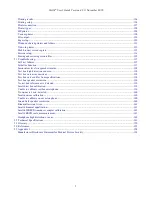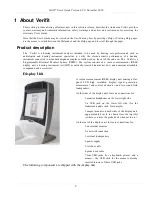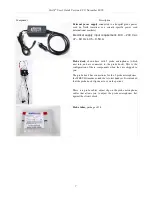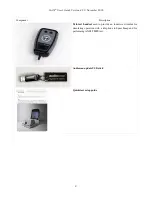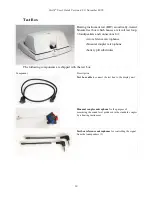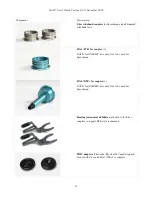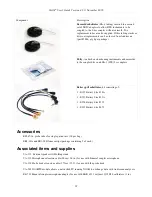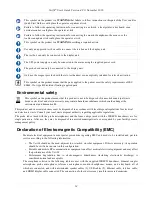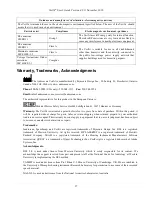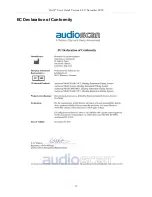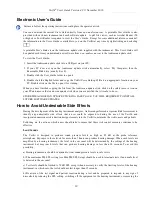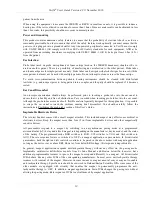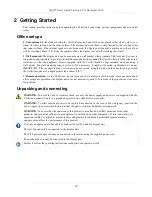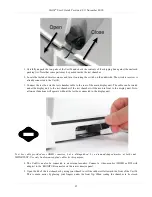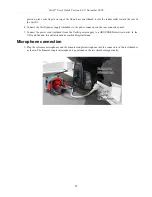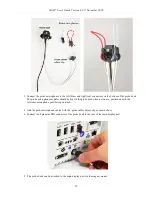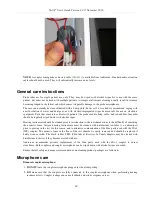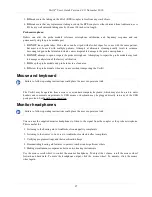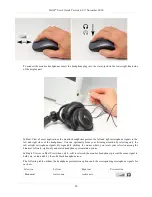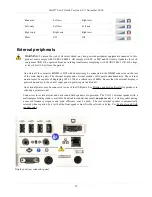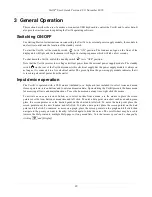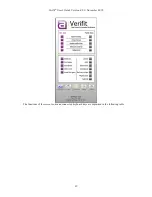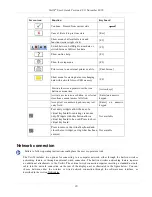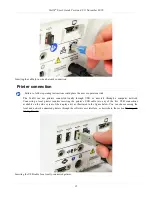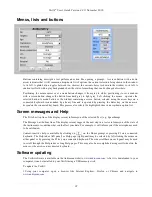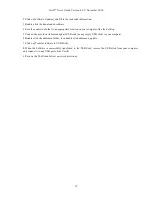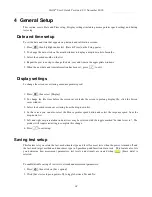
Verifit
®
User's Guide Version 4.8
©
November 2016
patient from the area.
When using the equipment to measure the WRECD or RECD in small ear canals, it is possible to induce a
hearing loss if the test is allowed to continue for more than 1 hour. Since accurate results can be obtained in less
than 10 seconds, this possibility should never occur in normal practice.
Power and Grounding
This product contains numerous safety features to ensure that the probability of electrical shock is as low as
reasonably practicable. In order to ensure that all of the safety features work optimally you must ensure that the
power cord is plugged into a grounded outlet. Any line-powered peripherals connected to Verifit must comply
with UL/IEC 60601-1 OR comply with UL or IEC or ISO safety standards for such equipment, AND a) be
operated from an isolating transformer complying with UL/IEC 60601-1, OR b) be kept at least 1.8m (6 ft..)
from the patient.
Ear Infection
Probe tubes (used on probe microphones) or foam eartips (used on the WRECD transducer) should not be re-
used on another patient. There is a possibility of transferring an ear infection to the other patient. Probe tubes
and foam eartips are for single-patient use only. Probe tubes can be wiped with alcohol wipes for re-use with the
same patient, but must not be used with multiple patients. Do not attempt to clean or re-use the foam eartips.
To avoid cross-contamination between patients, hearing instruments should be cleaned with disinfectant
towlettes (e.g., audiowipes) prior to being puttied into a coupler, and the putty should be replaced if it becomes
soiled.
Ear Canal Discomfort
An otoscopic examination should always be performed prior to inserting a probe tube into the ear canal to
ensure that it is healthy and free of obstructions. Care is needed when inserting probe tubes into the ear canal.
Although the probe tubes are made of soft, flexible material specially designed for this application, it is possible
to scrape the ear canal or touch the eardrum causing brief discomfort. You should carefully follow the
instructions in Positioning the probe tube section of this User’s Guide.
Implantable Electronic Device
The tele-test handset comes with a small magnet attached. This included magnet may affect some medical or
electronic devices. Keep the magnet more than 5cm (2 in.) from implantable devices and other magnetically
sensitive devices.
All pacemakers respond to a magnet by switching to an asynchronous pacing mode at a programmed
atrioventricular (AV) delay and a fixed magnet rate depending on the manufacturer, device model, and the status
of the battery. The programmed mode DDD switches to DOO, VVI switches to VOO, and AAI switches to
AOO. The rate response feature is switched to 'OFF' on magnet application in pacemakers. In biventricular
pacemakers, both the right and left ventricles continue to be paced in the above modes with magnet application
so long as the device is at or above ERI. However, from below ERI voltage, this response is unpredictable.
In general, magnet application suspends anti-tachycardia therapy without any effect on the pacing mode.
Implantable cardioverter defibrillator models from St. Jude Medical and Boston Scientific, however, have
additional programmable features to ignore the magnet or respond differently to a magnet. All biventricular
ICDs behave like any other ICDs of the corresponding manufacturer. In most cases, anti-tachycardia therapy
resumes with removal of the magnet. However, in some instances, magnet removal may or may not re-enable
anti-tachycardia therapy. Specific care should be exercised in Guidant/Boston Scientific ICDs since some of the
older models are equipped with circuitry that enables the magnet to permanently programme the anti-
tachycardia therapy to 'OFF'. In addition, magnet application on Sorin ICDs changes the pacing rate without
altering the pacing mode. Rate response of ICDs is not influenced by magnet application.
19
Summary of Contents for verifit
Page 1: ...Audioscan Verifit User s Guide 4 8 November 2016...
Page 17: ...Verifit User s Guide Version 4 8 November 2016 EC Declaration of Conformity 17...
Page 92: ...Verifit User s Guide Version 4 8 November 2016 92...
Page 94: ...Verifit User s Guide Version 4 8 November 2016 94...
Page 107: ...Verifit User s Guide Version 4 8 November 2016 Telecoil test results 107...
Page 123: ...Verifit User s Guide Version 4 8 November 2016 123...
Page 148: ...Verifit User s Guide Version 4 8 November 2016 148...
Page 149: ...Verifit User s Guide Version 4 8 November 2016 149...
Page 159: ...Verifit User s Guide Version 4 8 November 2016 159...

